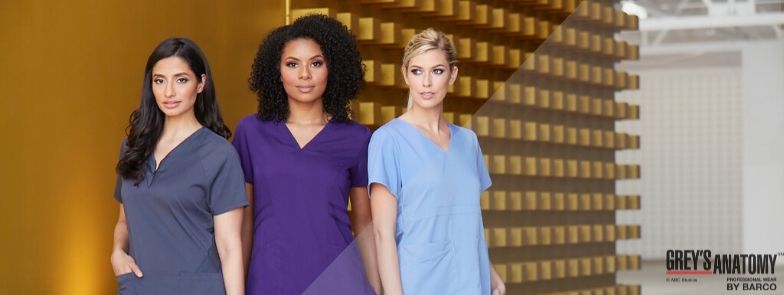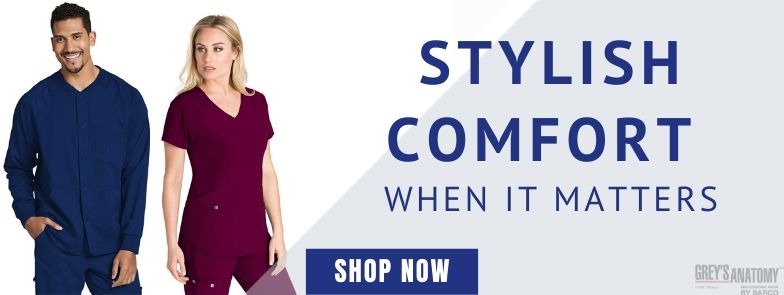How To Find Perfect Scrub Size
Finding the right scrub size and fit is important. Comfort and quality are both key when wearing scrubs, as medical professionals tend to spend several dozen hours a week in their scrubs, running from room to room, meeting patients, dealing with medical emergencies, and exposing themselves to contagions.
Top quality scrubs can help you stay mobile and active, avoid staining or smelling, and ward off a series of microbes with antimicrobial technology.
But the best quality scrubs won’t do you any good if the fit isn’t perfect. Picking the perfect scrub size and fit takes a little time, and a little reading – but we promise you that you’ll know everything you need to know to pick out the right scrubs for you once you’re through with this little guide.
Get Your Measurements
First things first: your numbers. The most important detail to keep in mind when picking the perfect scrub size is your measurements, so make sure to get them right. Don’t rely on old measurements when you’re in the market for new scrubs – you’ll want the most up-to-date and accurate measurements you can get. The four measurements you will want are your:
- Inseam
- Hips
- Waist
- Chest/bust
Some general tips: Try and measure yourself first thing in the morning. That way, you don’t have to worry as much about bloating adding inches to your waist.
Also, don’t suck your stomach in. If you’re setting out to measure yourself, measure your waist as it would be throughout the day. Don’t try to squeeze yourself into a smaller measurement, either. Keep the measuring tape snuggly on your skin, without twisting but without leaving much breathing room.
Tips for Correct Measurements
When taking your measurements, it helps to have a friend. You can try and measure yourself, but it won’t be as accurate. A friend can help make sure that the measuring tape is always level, and that you can keep a proper posture up.
Speaking of which, proper posture is important when taking your measurements. Sure, your height won’t be very important when getting some scrubs, but your posture can affect your bust and waist measurements. Keep your butt and core tense (without straining), your chest out, eyes neutral (focus on a spot on the wall), feet at shoulder width, and shoulders slightly back.
Getting accurate numbers is important. Your numbers will determine how everything else comes together. If you’re looking for a specific style (maybe contouring, or slightly roomier; something fitting, or something looser), look for a specific style rather than a going a size up or down.
If you do decide to adjust for scrub size (especially if one measurement is much bigger than the rest), always go a size up and use your biggest measurement proportionally to determine what size you are. You can always visit a tailor to adjust your scrubs if need be.
Identify the Fit
Your scrubs’ ‘fit’ or style, as well as its tailoring, is important when picking the right set of scrubs. Scrubs come in many different fits, with plenty of variation from company to company, but some general fits that you’ll find nearly everywhere include:
- Modern/Missy/Contemporary: more fitting, designed to follow a woman’s curves and accentuate a female physique.
- Classic: Less focus on curves, allowing the fabric to flow more freely over the shoulders and hips.
- Unisex/Men’s: Cut to adjust to a man’s shoulders, providing a good fit for most people without accentuating any curves. Usually cut with larger arm room in the sleeves as well.
Other more specific fits are designed to fit certain clientele, such as petite scrubs (for men and women under 5’4) and tall scrubs (for women over 5’8 and men over 6’2). Maternity fits also exist, cut to leave room for a growing baby.

Check the Fabric
Depending on how close you are to the limit of your current size, you may want to look into fabric that deliberately stretches a little, and gives way, rather than remaining stiff.
Pure cotton scrubs are especially tough to manage, as they are prone to shrinkage. If you pick a cotton polyester blend, keep in mind that it doesn’t stretch. If you want stretch, look for something with a bit of spandex blended into it.
Color Options
Of course, there’s still a little more to picking the right scrub size and fit. One last aspect to cover is color. It’s relatively simple: if you’re working in a hospital or clinic with a strict color dress code (for example, surgeons would wear blue while nurses wear green and support staff wear maroon), or a dress code based on the clinic’s logo (some clinic’s ask their staff to wear colors complementary to the design of the clinic itself), then your color options are naturally restricted.
However, if it’s entirely up to you, then your color palette is honestly a matter of personal preference.
- Try to stick with two colors, or three if two of them complement each other and are both warm or both cold.
- Too many colors are a little like bringing too many chefs into the kitchen.
- Alternatively, you can have one vibrant color, and then a primary color that’s much less intrusive visually, like grey, brown or very dark blue.
Does Scrub Size, Fit and Appearance Matter?
Scrubs are not just a very practical uniform for medical personnel, they can also be an opportunity to express yourself and make a great first impression on a patient. By picking scrubs with a flattering fit, the right size, and a pleasant selection of color, you’re going to have a more pleasant time interacting with patients.
Both nurses and patients feel that nurse appearance plays a significant role in first impressions, and that a nurse’s image in front of the patient is important. One might wonder why appearance affects performance in something as clear-cut as medicine. After all, it’s the medication prescribed and skill of the professional that determines an outcome, right?
A patient’s healing begins within. Doctors, nurses, and medication help along, removing critical obstacles on the way to healing, and helping the system recover – but a patient’s own confidence in their medical care can have a tremendous mental (and subsequently physical) impact on their own recovery.
In other words, a patient who has faith in the people working on them is more likely to make a swift recovery from disease. And as superficial as it sounds, a good, professional impression can help patients express faith in the nurses and doctors working hard to improve their lives.
To make a great first impression and perhaps even help patient outcomes, maintain a professional appearance with the right pick of scrubs.



